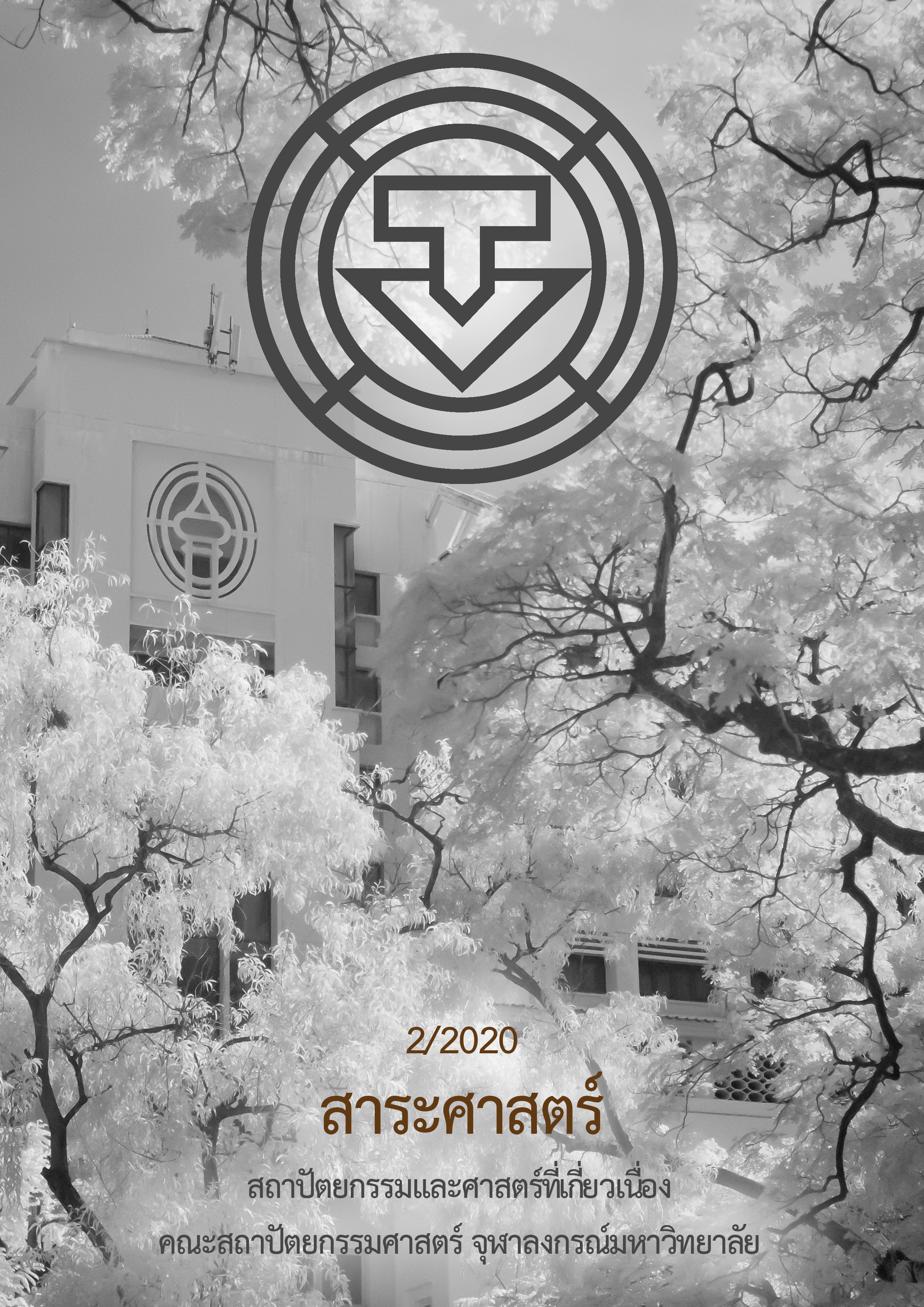Rooftop Urban Agriculture Design and Sustainability Benefits in Bangkok Area
Main Article Content
Abstract
Rooftop Urban Agriculture (RA) is one of many systems for optimizing the land for Agricultural production in major urban cities around the world. With varieties of practices, stakeholders, objectives, design considerations, and occurred benefits.
This study focused on the design and the benefits of Rooftop Urban Agriculture in Bangkok Metropolitan Area (BMA). The method was ranging from reviewing related literature, choosing study areas and interviewing responsible staff. Then analyzed and compared acquired project information in terms of design considerations and sustainability benefits; comprise of social, environmental, and economic.
Findings from Rooftop Urban Agriculture in BMA can be categorized into the built-in projects that came with the design of the buildings and the projects that installed later on. The design considerations consist of several issues such as site area examination, which is vital to have convenient access for long-term maintenance and having protection from wind and sunlight that conform to the building usage. In construction, the built-in projects show a better readiness in usage but the installed projects also held good examples of lightweight cultivation innovations. The design elements must be considered in terms of the suitability of the plant types; small shrubs, short-term vegetables, climbers and medium shrubs with building space and structure. Lastly, for maintenance, the project manager must hold a considerable knowledge of rooftop applicable soil maintenance, irrigation, and controlling of production quality and pests.
The most visible Social benefit is for the projects to be the agricultural learning space for metropolitans and being the identity and knowledge representation area for the projects team members which largely are workforces from the supporting organizations. The evident Environmental benefits are to enhance landscape aesthetics and contribute to the conservation of energy, water usage, and waste management for the building. Finally, the prominent Economic benefits are to create a good public corporate image for supporting organizations and raise awareness for economical potentials of urban rooftops.
Article Details
References
คำรณ สวัสดิ์พูน. สัมภาษณ์. 5 กุมภาพันธ์ 2563.
ชูเกียรติ โกแมน. สัมภาษณ์. 23 มกราคม 2563.
ทำเนียบ อุฬารกุล, ค. จ. ว. พ. “การริเริ่มสวนดาดฟ้าโดยบุคลากรระดับล่าง: กรณีศึกษาสำนักงานเขตหลักสี่.” การประชุมวิชาการทางสถาปัตยกรรม “สรรค์สาระสถาปัตยกรรมพื้นถิ่นและสภาพแวดล้อมทางวัฒนธรรม ประจำปี 2559”, คณะสถาปัตยกรรมศาสตร์ มหาวิทยาลัยขอนแก่น, 2559.
นฤมล อรุโณทัยและอุษา โคตรศรีเพชร. เกษตรในเมือง/สวนผักคนเมืองกับการฟื้นฟูระบบนิเวศ-สังคมในเมืองใหญ่. กรุงเทพฯ: สถาบันวิจัยสังคม จุฬาลงกรณ์มหาวิทยาลัย, 2560.
นาถศิริ โกมลพันธุ์. ปลูกกล้าน้อยกลางเมือง. นนทบุรี: มูลนิธิเกษตรกรรมยั่งยืน, 2559.
พชร เลิศปิติวัฒนา. การออกแบบสวนหลังคาในกรุงเทพมหานคร. กรุงเทพมหานคร: ภาควิชาภูมิสถาปัตยกรรม คณะสถาปัตยกรรมศาสตร์ จุฬาลงกรณ์มหาวิทยาลัย, 2547. สืบค้น 14 ตุลาคม 2562. http://cuir.car.chula.ac.th/dspace/handle/123456789/2357.
พัสรินณ์ พันธุ์แน่น "การพัฒนาสวนเกษตรชุมชนเมืองกับการเสริมสร้างชุมชนเข้มแข็ง: กรณีศึกษา ชุมชนพูนทรัพย์ เขตสายไหม กรุงเทพมหานคร." วารสารร่มพฤกษ์ มหาวิทยาลัยเกริก 36, 3(2561): 67-95.
พาสินี สุนากรและปิยะพงษ์ บุษบงก์. มือเกษตรบนอาคาร. กรุงเทพฯ: ภาควิชานวัตกรรมอาคารและภาควิชาภูมิสถาปัตยกรรม คณะสถาปัตยกรรมศาสตร์ มหาวิทยาลัยเกษตรศาสตร์, 2559.
เพ็ญศรี โตสะอาด. คู่มือการทำเกษตรอินทรีย์แบบพอเพียงบนพื้นที่จำกัด. กรุงเทพมหานคร: สำนักงานเขตหลักสี่, 2558.
ภคิษฐ์คมณ์ แสงตรีเพชรกล้า. “ปัจจัยที่มีความสัมพันธ์กับความรู้เกี่ยวกับการทำเกษตรในเมืองของผู้เข้าร่วมอบรม: กรณีศึกษาที่ศูนย์การเรียนรู้ห้องเรียนธรรมชาติ สวนเกษตรดาดฟ้า เขตหลักสี่ กรุงเทพมหานคร.” วิทยานิพนธ์ปริญญามหาบัณฑิต สาขาวิชาส่งเสริมการเกษตร มหาวิทยาลัยเกษตรศาสตร์ม, 2559.
“มุมมองจากสวนสาธารณะอาคาร สสส. สถาปัตยกรรมเพื่อสุขภาวะที่ดีและเป็นมิตรกับสิ่งแวดล้อม.” สืบค้น 10 กุมภาพันธ์ 2563. www.scgbuildingmaterials.com/th/LivingIdea/ArchitectLifestyle/Architecture-for-Health-and-Environment.aspx.
สวนผักคนเมือง. “แหล่งเรียนรู้เกษตรในเมือง.” สืบค้น 10 กุมภาพันธ์ 2563. http://www.thaicityfarm.com/ Trainingcenter.
สำนักงานคณะกรรมการวิจัยแห่งชาติ. "แผ่นปลูกพืชบนหลังคา." สืบค้น 28 เมษายน 2563. www.i4biz.nrct.go.th/ NRCT_PLATINUM58/home/show_product.php?research_id=334.
Adams, W.M. The Future of Sustainability: Re-thinking Environment and Development in the Twenty-First Century. Gand: International Union for Conservation of Nature (IUCN), 2006.
Alsanius, B. W., Andria Kosiba Held, Martine Dorais, Cecilia Moraa Onyango and Lars Mogren. “Produce Quality and Safety.” Rooftop Urban Agriculture (2017): 195-216.
Batty, M. "Cities in a Completely Urbanized World.” Environment and Planning B: Planning and Design 42, 3(2015): 381-383.
Caputo, S., Pedro Iglesias and Heather Rumble. “Elements of Rooftop Agriculture Design.” Rooftop Urban Agriculture (2017): 39-59.
Dubbeling, M., F., Orsini, and G., Gianquinto. “Introduction.” Rooftop Urban Agriculture (2017): E1-E1.
Hribar, Š., et al. Participatory Urban Agriculture Governance Plan for Fighting Social Exclusion in the Danube Region. Seregelyesiut: Central Transdanubian Regional Innovation Agency, 2019.
Luckett, K. Green Roof Construction and Maintenance. New York: McGraw-Hill, 2009.
Montero, J. I., Esteban Baeza, Pere Munoz and Esther Sanye-Mengual. “Technology for Rooftop Greenhouses.” Rooftop Urban Agriculture (2017): 83-101.
Mougeot, L. J. A. Agropolis: the Social, Political, and Environmental Dimensions of Urban Agriculture. Ottawa: International Development Research Centre, 2005.
Mougeot, L. J. A. (2000). Urban Agriculture: Definition,Presence, Potentials and Risks, and Policy Challenges. Ottawa: International Development Research Centre (IDRC), 2000.
Nasr, J., J. K., and H., de Zeeuw. “A Panorama of Rooftop Agriculture Types.” Rooftop Urban Agriculture (2017): 9-29.
Orsini, F. Rooftop Urban Agriculture. New York, NY.: Springer, 2017.
Philips, A. Designing Urban Agriculture: A Complete Guide to the Planning, Design, Construction Maintenance and Management of Edible Landscapes. Hoboken,NJ.: John Wiley and Sons, 2013.
Quesnel, A., J., Foss, and N., Danielsson. “Solutions from Above: Using Rooftop Agriculture to Move Cities Towards Sustainability.” Master of Strategic Leadership towards Sustainability, School of Engineering Karlskrona, Blekinge Institute of Technology, Sweden, 2011.
Sanyé-Mengual, E., et al. "Resolving Differing Stakeholder Perceptions of Urban Rooftop Farming in Mediterranean Cities : Promoting Food Production as a Driver for Innovative Forms of Urban Agriculture." Agriculture and Human Values 33, 1(2015): 101-120.
Smit, J., J., Nasr, and A., Ratta. Urban Agriculture: Food, Jobs and Sustainable Cities. (n.p.): The Urban Agriculture Network, Inc., 2001.
Tsirogiannis, I. L., Francesco Orsini and Paulo Luz. “Water Management and Irrigation Systems.” Rooftop Urban Agriculture (2017): 129-146.
United Nations. Brundtland Report: Report of the World Commission on Environment and Development: Our Common Future. Oxford: Oxford University, 1987.
Viljoen, A., and K., Bohn. Second Nature Urban Agriculture: Designing Productive Cities. Abingdon, Oxon: Routledge, 2014.


